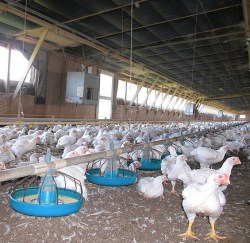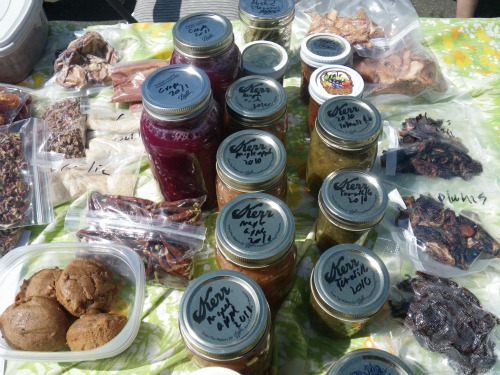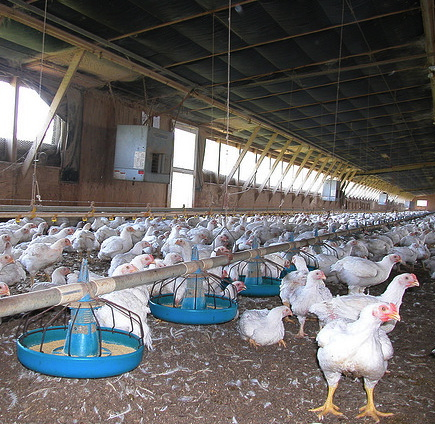 If you saw “Arsenic in Our Chicken?,” Nick Kristof’s much-read New York Times column from earlier this month, you’ve heard about the widespread use of some unexpected additives in chicken farming.
If you saw “Arsenic in Our Chicken?,” Nick Kristof’s much-read New York Times column from earlier this month, you’ve heard about the widespread use of some unexpected additives in chicken farming.
Studies released this year detected caffeine, acetaminophen (the active ingredient in Tylenol), fluoxetine (the active ingredient in Prozac), various antibiotics, arsenic, and more in feather meal, a substance made from ground poultry feathers and used in animal feed. The findings were the results of studies by the Johns Hopkins Center for a Livable Future and Arizona State University.
“I grew up on a farm, and I thought I knew what to expect in my food. But Benadryl? Arsenic?” Kristof wrote. The studies, he added, “raise serious questions about the food we eat and how we should shop.”
Where arsenic is concerned, his alarm is not unfounded. For decades, chicken producers have used arsenic as a way to boost the birds’ growth and cut down on production costs. Last year, the Food and Drug Administration (FDA) tested 100 chickens that had been raised on a popular arsenic-based additive called Roxarsone, and found that half the chickens had inorganic arsenic in their livers — a known carcinogen that can cause cancer even at the low levels found naturally in our environment.
Rather than banning Roxarsone, however, the FDA decided to partner with manufacturer AlPharma, a subsidiary of Pfizer, to hammer out a compromise. In July 2011, Pfizer agreed to voluntarily suspend sales of Roxarsone, drawing praise from the agency. But the “voluntary” nature of the decision means that Pfizer can continue to market other drugs containing arsenic, and that it could begin selling Roxarsone in the U.S. again at any time. (AlPharma is the largest single manufacturer of arsenical drugs, and the handful of other pharmaceutical companies that produce arsenic for use in animal feed have not received the same attention from the FDA.)
Some officials in Maryland — one of three states that make up the Delmarva Peninsula, a heavily concentrated chicken-producing region, and home to many vulnerable waterways — want more of a guarantee. So, earlier this month, in a historic vote, the state became the first to ban the use of arsenic in chicken feed. The bill, which was introduced three years in a row [and was reported on a year ago by Grist’s former Food Editor Tom Philpott], finally got some traction in the Maryland legislature thanks to the tireless efforts of Delegate Tom Hucker and Sen. Paul Pinsky. Maryland’s governor is expected to sign the bill in the coming weeks.
Roxarsone was green-lit by the FDA in 1944 to reduce disease in crowded chicken coops, promote poultry growth, and give raw chicken flesh that pleasant pink glow under supermarket fluorescence. Today, 70 percent of the nearly 9 billion broiler chickens raised in the U.S. are fed arsenic additives, according to the Institute for Agriculture and Trade Policy [PDF].
The upshot? For years, discerning consumers like Kristof, purchasing what they thought was safe poultry for their families, may have been inadvertently feeding their loved ones a poison that has also been used to kill rats and preserve wood.
And the practice even affects people who wouldn’t dream of eating chicken, since most (up to 75 percent) of that arsenic passes through chickens and becomes 26 to 55 billion pounds of arsenic-laced chicken manure. Then, as much as 90 percent of that manure is applied as fertilizer for crops and fields, where it ultimately leaches into groundwater and waterways — a fact Maryland Attorney General Douglas Gansler addressed in a recent editorial in the Washington Post.
Over 25,000 pounds of arsenic are introduced each year into Maryland’s environment through chicken feed, according to testimony by Keeve Nachman, a scientist at the Johns Hopkins Bloomberg School of Public Health.
Now, thanks to the new law, Maryland residents can swallow a little easier.
Since the bill passed, the National Caucus of Environmental Legislators has approached Hucker about working with representatives in other states to introduce complimentary bills. “Other states are looking at Maryland,” Hucker said recently over the phone. “We’ve laid the ground work.”
The state’s poultry growers are less than pleased. Lobbyists for the Delmarva Poultry Industry located on Maryland’s eastern shore, as well as the Maryland Grain Producers Association, testified against the bill for many years running. And they weren’t alone. Hucker says Pfizer hired several high-profile lobbyists to work alongside poultry industry representatives, despite the fact that the company took Roxarsone off the market last year.
Not that all chicken suppliers approve of arsenic additives. McDonald’s doesn’t allow its poultry suppliers to use Roxarsone. And Maryland-based Perdue Farms, currently the third largest poultry company in the U.S., also stopped using the drug in 2007.
But the majority of poultry growers have vigorously defended the industry’s use of arsenic, arguing that consumers are exposed to the compound elsewhere anyway.
Mike Brown, president of the National Chicken Council, responded to Kristof’s NYT piece this way: “Mr. Kristof doesn’t mention that arsenic occurs naturally and is widely present in both soil and water. It is found in many food[s] we eat and water we drink,” Brown wrote in a letter to the editor.
And indeed, this kind of logic will likely be applied to regulation attempts in other states in the future. But while arsenic is found in our environment, a growing body of scientific evidence suggests that organic arsenic — the type found in Roxarsone — can transform into inorganic arsenic and remain in human tissue. Chronic exposure to arsenic is associated with increased risk for many types of cancer, including bladder, kidney, lung, liver, and colon, as well as heart disease.
And we’re eating a lot of the stuff! A 2003 study by USDA researcher Tamar Lasky published in Environmental Health Perspectives found that the average American ingests 3.6 to 5.2 micrograms of inorganic arsenic every day from chicken alone, (of course, some chicken lovers probably eat many times that amount). According to calculations by Food and Water Watch [PDF], the World Health Organization recommends that no one consume more than 22.7 micrograms per pound per day of inorganic arsenic, but when combined with the often high levels of arsenic found in farm fields and groundwater, the cumulative impact could be large.
The arsenical drugs on the market were approved in the ’40s. Since then, chicken farming has become increasingly industrialized. In 1950, 78 percent of American farms raised chickens. Soon, however, they were moved into “houses” or coops as large as 100,000 birds, and by 1992, only 5.6 percent of the nation’s farms raised chickens [PDF]. Meanwhile, Americans now consume two and a half times more chicken.
The good news is that states don’t have to wait for federal regulation to protect their constituents from arsenic-laced chicken. But state legislators looking to take the situation into their own hands will have to choose the best available science over powerful industry lobbying. At least now they can now look to Maryland as an example.
Correction: As first published this article incorrectly stated the name of the drug in which acetaminophen is the active ingredient. Grist regrets the error.



